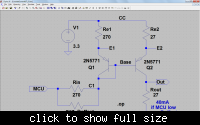Elio Magnus
Newbie level 4
- Joined
- Mar 9, 2011
- Messages
- 7
- Helped
- 0
- Reputation
- 0
- Reaction score
- 0
- Trophy points
- 1,281
- Location
- Porto Alegre - RS - Brazil
- Activity points
- 1,347
Hello
I did use the DAC7611 with a PIC16f876A. It´s very precisious.
My project is to generate programmable wave form.
For low impedance output I used a operational amplifier (buffer).
Elio
I did use the DAC7611 with a PIC16f876A. It´s very precisious.
My project is to generate programmable wave form.
For low impedance output I used a operational amplifier (buffer).
Elio
